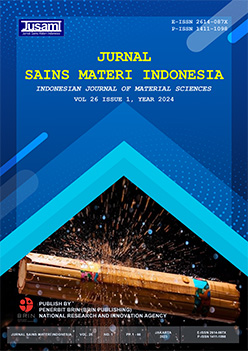Simulation Of Mechanical Stress On A Solution-Annealed 15-15Ti Steel Using ABAQUS CAE Program
DOI:
https://doi.org/10.55981/jsmi.2024.3800Keywords:
15-15Ti Steel, Tensile Test, Mechanical Properties, Abaqus Program, Fracture PhenomenonAbstract
In addressing the problem of Ti steel (15-15Ti) proposed as the main candidate material for the manufacture of coatings and fuel wrappers for liquid LBE-cooled fast reactors at high temperatures related to material degradation, such as liquid metal embrittlement (LME) and liquid metal corrosion (LMC), Gong et al. conducted research related to the creep failure behavior of solution-annealed 15-15Ti steel exposed to LBE at temperatures of 550 and 600oC using a creep test facility. However, in this study, testing the mechanical properties of 15-15Ti steel through tensile testing was not really discussed, even though the mechanical properties of a material are one of the most important things in determining structural design. The mechanical properties obtained from previous research were then simulated using ABAQUS CAE software to determine the stress distribution profile (initial and final) and the mechanical stress-strain performance used to understand more about the 15–15Ti material. From the simulation results, it was found that the peak force received by the specimen for a strain rate of 1.1 x 10-5s-1 was 6.0 kN, while for a strain rate of 5 x 10-5s-1, it was 6.2 kN. This means that the specimen used cannot accept a force greater than the peak force value. A stress-strain difference graph was also obtained in the experimental results, with simulation results showing a decrease in the value of the fracture point. This is because the mesh setting in the simulation is not close to a more detailed value.
Downloads
References
P. Yvon, Structural Materials for Generation IV Nuclear Reactors. Woodhead Publishing, 2016.
L. I. Chengliang and Y. Mengjia, “The Challenge of Nuclear Reactor Structural Materials for Generation IV Nuclear Energy Systems,” Nucl. Energy, no. SMiRT 20, pp. 1–8, 2009.
N. E. Agency, “Handbook on Lead-bismuth Eutectic Alloy and Lead Properties , Materials Compatibility , Thermal- hydraulics and Technologies,” Nucl. Sci., pp. 647–730, 2015.
L. K. Mansur, A. F. Rowcliffe, R. K. Nanstad, S. J. Zinkle, W. R. Corwin, and R. E. Stoller, “Materials needs for fusion, Generation IV fission reactors and spallation neutron sources - Similarities and differences,” J. Nucl. Mater., vol. 329–333, no. 1-3 PART A, pp. 166–172, 2004, doi: 10.1016/j.jnucmat.2004.04.016
K. L. Murty and I. Charit, “Structural materials for Gen-IV nuclear reactors: Challenges and opportunities,” J. Nucl. Mater., vol. 383, no. 1–2, pp. 189–195, 2008, doi: 10.1016/j.jnucmat.2008.08.044.
Y. Zhuang et al., “Microstructure and high temperature mechanical properties of the new cladding steel of 15Cr-15Ni-Ti-Y,” Nucl. Mater. Energy, vol. 31, no. May, p. 101200, 2022, doi: 10.1016/j.nme.2022.101200.
V. Tsisar, C. Schroer, O. Wedemeyer, A. Skrypnik, and J. Konys, “Corrosion behavior of austenitic steels 1.4970, 316L and 1.4571 in flowing LBE at 450 and 550°C with 10-7 mass% dissolved oxygen,” J. Nucl. Mater., vol. 454, no. 1–3, pp. 332–342, 2014, doi: 10.1016/j.jnucmat.2014.08.024.
V. Tsisar, C. Schroer, O. Wedemeyer, A. Skrypnik, and J. Konys, “Long-term corrosion of austenitic steels in flowing LBE at 400 °c and 10-7 mass% dissolved oxygen in comparison with 450 and 550 °c,” J. Nucl. Mater., vol. 468, pp. 305–312, 2016, doi: 10.1016/j.jnucmat.2015.09.027.
E. Charalampopoulou, R. Delville, M. Verwerft, K. Lambrinou, and D. Schryvers, “Transmission electron microscopy study of complex oxide scales on DIN 1.4970 steel exposed to liquid Pb-Bi eutectic,” Corros. Sci., vol. 147, no. April 2018, pp. 22–31, 2019, doi: 10.1016/j.corsci.2018.10.018.
X. Gong et al., “Creep failure of a solution-annealed 15-15Ti steel exposed to stagnant lead-bismuth eutectic at 550 and 600 °C,” Mater. Sci. Eng. A, vol. 798, no. September, 2020, doi: 10.1016/j.msea.2020.140230.
A. Strafella, A. Coglitore, and E. Salernitano, “Creep behaviour of 15-15Ti(Si) austenitic steel in air and in liquid lead at 550°C,” Procedia Struct. Integr., vol. 3, pp. 484–497, 2017, doi: 10.1016/j.prostr.2017.04.061.
W. D. and M. V. Niels Cautaerts, Rémi Delville, Thermal creep properties of Ti-stabilized DIN 1.4970 (15-15Ti) austenitic stainless steel pressurized cladding tubes Niels, vol. 45, no. 4. 2019. doi: 10.1016/j.jnucmat.2017.06.013.This.
L. Li, C.-Q. Li, and M. Mahmoodian, “Effect of Applied Stress on Corrosion and Mechanical Properties of Mild Steel,” J. Mater. Civ. Eng., vol. 31, no. 2, pp. 1–13, 2019, doi: 10.1061/(asce)mt.1943-5533.0002594.
X. Gong, R. Li, M. Sun, Q. Ren, T. Liu, and M. P. Short, “Opportunities for the LWR ATF materials development program to contribute to the LBE-cooled ADS materials qualification program,” J. Nucl. Mater., vol. 482, pp. 218–228, 2016, doi: 10.1016/j.jnucmat.2016.10.012.
A. Setiawan, “Stress-Strain Response Material Polymer Poly Lactid Acid dengan Experimental Measurements dan Numerical Simulations,” J. Tek. Elektron. Engine, vol. 6, no. 1, pp. 10–16, 2020.
Unknown, “Modulus of Elasticity.” https://www.instron.com/en/resources/glossary/modulus-of-elasticity
Bakri and S. Chandrabakty, “Efek waktu perlakuan panas temper terhadap kekuatan tarik dan ketangguhan impak baja komersial,” J. SMARTek, vol. 4, no. 2, pp. 97–107, 2006.
I. K. Rimpung and I. G. O. Pujihadi, “Analisis perubahan kekuatan tarik baja (St. 42) dengan perlakuan panas 800◦C,” J. Log., vol. 17, no. 2, pp. 1–5, 2017.
S. Chambers, “Elongation : What Is It and Why Does It Matter?,” 2020. https://www.strouse.com/blog/what-is-elongation
E. D’angelo, “Stress-strain relationships during uniform and nona uniform expansion of isolated lungs,” Respir. Physiol., vol. 23, no. 1, pp. 87–107, 1975, doi: 10.1016/0034-5687(75)90074-2.
C. Y. Lin and J. H. Kang, “Mechanical properties of compact bone defined by the stress-strain curve measured using uniaxial tensile test: A concise review and practical guide,” Materials (Basel)., vol. 14, no. 15, pp. 1–16, 2021, doi: 10.3390/ma14154224.
Muslikh, M. Iman, and A. F. Setiawan, “Pemodelan Elemen Hingga Struktur Menggunakan Abaqus,” no. February 2022, pp. 8–9, 2020.
D. M. T. D. Herilna, Menggunakan Program ABAQUS CAE V6 . 14 Pada Gedung Hotel IBIS STYLE Dalam Wilayah Gempa III. 2019.
Azhar, “Analyzing the Tensile Strength of AISI 1045 Coil Springs in Avanza 2020 Cars : A Comparative Study of Experimental Results using Simulation Technology,” J. Eng. Sci., vol. 1, no. 2, pp. 56–71, 2022.
R. N. Arini and R. Pradana, “Analisa Tegangan Regangan Pada Balok Dengan Menggunakan Software ABAQUS CAE V6 . 14,” J. Artesis, vol. 1, no. 2, pp. 193–198, 2021.
Y. Zhuang et al., “Effects of yttrium oxides on the microstructure and mechanical properties of 15-15Ti ODS alloy fabricated by casting,” Mater. Charact., vol. 162, no. August 2019, 2020, doi: 10.1016/j.matchar.2020.110228.
D. I. Sakti et al., “Studi Perbandingan Investigasi Modulus Elastisitas Antara Metode Uji Tarik dengan Metode Indentasi Pada Material Styrene BUTADIENE RUBBER 25 (SBR-25),” J. Tek. Mesin S-1, vol. 11, no. 2, pp. 147–156, 2023.
M. A. Rofiq, H. Alrasyid, D. Iranata, and D. Irawan, “Prediksi Perilaku Lentur Kolom Beton Bertulang Mutu Tinggi Terhadap Kombinasi Beban Perpindahan Monotonik dan Aksial Rendah,” J. Apl. Tek. Sipil, vol. 16, pp. 43–50, 2019.
J. Peirs, P. Verleysen, and J. Degrieck, “Experimental study of the influence of strain rate on fracture of Ti6Al4V,” Procedia Eng., vol. 10, no. June 2016, pp. 2336–2341, 2011, doi: 10.1016/j.proeng.2011.04.385.
G. E. Dieter, Mechanical metallurgy. McGRAW-HILL BOOK COMPANY, 1961.
A. D. Gudayu, L. Steuernagel, and D. Meiners, “The capability of ABAQUS/CAE to predict the tensile properties of sisal fiber reinforced polyethylene terephthalate composites,” Compos. Adv. Mater. J., vol. 31, p. 263498332211376, 2022, doi: 10.1177/26349833221137602.
Downloads
Published
How to Cite
Issue
Section
License
Copyright (c) 2024 Putra Oktavianto, Anik Purwaningsih, Muksin Aji Setiawan, Airin Hijrah Handayani, Asril Pramutadi Andi Mustari, Abdul Waris

This work is licensed under a Creative Commons Attribution-ShareAlike 4.0 International License.








